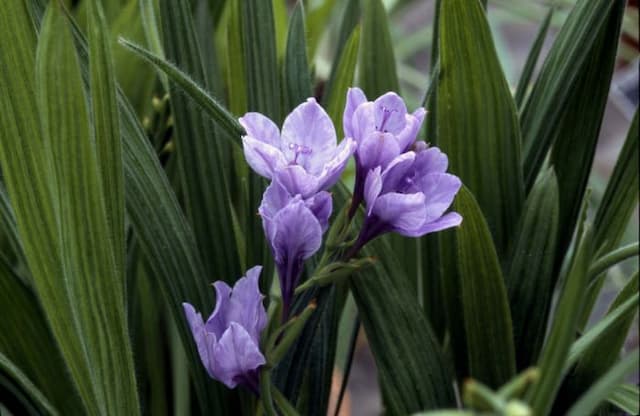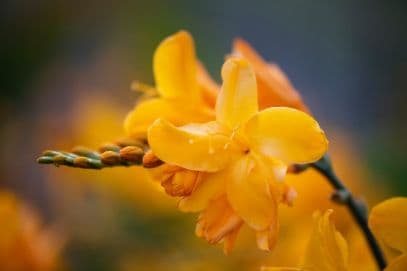Kent Pride Iris Iris 'Kent Pride' (TB)

ABOUT
Iris 'Kent Pride', also known as "Kent Pride" Iris, is a captivating plant known for its striking flowers. The blooms showcase a beautiful combination of colors—typically a rich, deep burgundy or reddish-brown standards (the upright petals), harmoniously contrasted with falls (the downward-curving petals) that are often brushed with a golden bronze or mustard yellow tone. A distinct feature of 'Kent Pride' is its prominent beards, which are the fuzzy extensions on the falls, standing out in bright orange or gold, adding to the overall exotic and warm appearance of the flower. The petals are often ruffled or slightly wavy, adding textural interest and a sense of movement to the overall floral display. 'Kent Pride' blooms in late spring to early summer, making a dramatic statement in the garden when it does. Surrounding the flowers, the foliage of 'Kent Pride' consists of elongated, sword-like leaves that are typically a vibrant green color. These leaves grow in a clumping manner, forming an attractive, structured base for the stunning flowers that rise above them on sturdy stems. The foliage remains aesthetically pleasing even when the plant is not in bloom, providing a contrasting backdrop to other plants in the garden. Together, the bloom colors and the elegant greenery of the Iris 'Kent Pride' make it a highly sought-after variety for gardeners looking to introduce a touch of dramatic flair and sophistication to their flower beds or borders.
About this plant
 Names
NamesFamily
Iridaceae
Synonyms
Kent Pride Iris, Tall Bearded Iris
Common names
Iris 'Kent Pride' (TB)
 Toxicity
ToxicityTo humans
Tall Bearded Iris, like many other iris species, contains irisin, iridin, or irisine - substances that can be toxic if ingested. Although the likelihood of severe poisoning is generally low, consuming parts of the iris, particularly the rhizomes (underground stems), can lead to digestive discomfort, including nausea, vomiting, abdominal pain, and diarrhea. In rare cases, prolonged contact with the sap can cause skin irritation or an allergic reaction.
To pets
The Tall Bearded Iris can be toxic to pets if ingested. The rhizomes contain compounds that can cause gastrointestinal issues such as drooling, vomiting, diarrhea, and abdominal pain. Seek veterinary attention if your pet shows symptoms of iris poisoning.
 Characteristics
CharacteristicsLife cycle
Perennials
Foliage type
Deciduous
Color of leaves
Green
Flower color
Mixed
Height
2-3 feet (60-90 cm)
Spread
1-2 feet (30-60 cm)
Plant type
Bulb
Hardiness zones
3-9
Native area
Europe
Benefits
 General Benefits
General Benefits- Visual Appeal: Adds striking color with its vibrant copper and burnt orange blossoms accented by a deep wine-purple falls.
- Garden Design: Can be used as a focal point in garden beds and borders due to its showy flowers.
- Pollinator Attraction: Attracts bees, butterflies, and other beneficial pollinators, supporting local ecosystems.
- Low Maintenance: Generally easy to care for once established, requiring minimal upkeep.
- Drought Tolerance: Once established, possesses a degree of drought resistance, reducing the need for frequent watering.
- Cold Hardy: Able to withstand cooler temperatures, making it suitable for a variety of climates.
- Breeding: Ideal for iris breeders due to its unique coloration and characteristics that can enhance hybridization.
- Seasonal Interest: Provides a burst of color in late spring to early summer, enlivening the garden during this time.
- Cut Flowers: Excellent for cutting gardens, providing long-lasting blooms that add elegance to floral arrangements.
- Propagation: Can be propagated through division, allowing gardeners to expand their garden or share with others.
 Medical Properties
Medical PropertiesThis plant is not used for medical purposes.
 Air-purifying Qualities
Air-purifying QualitiesThis plant is not specifically known for air purifying qualities.
 Other Uses
Other Uses- Crafting Natural Dyes: Iris 'Kent Pride' petals can be used to create natural dyes for textiles, offering hues ranging from soft blues to deep purples.
- Photography Subject: With its striking colors, the iris can serve as an excellent subject for botanical photography and garden portraiture.
- Garden Design: Irises can be used to create a 'river' of color in garden designs, guiding the eye along through color and form.
- Fragrance Extraction: Some irises, including 'Kent Pride,' can be used in the production of high-quality perfumes due to their delicate scent.
- Culinary Garnish: While not commonly consumed, the petals of some iris varieties may be used as a decorative, edible garnish on salads and desserts.
- Floral Arrangements: Irises can be used as a focal point in cut flower arrangements, adding height and drama to the composition.
- Artistic Inspiration: The unique form and color of the iris can inspire artists and be depicted in various styles of painting and illustration.
- Bioindicator Species: In some circumstances, the iris can be used as a biological indicator for wetland health and water quality.
- Seasonal Celebrations: In certain cultures, irises may play a role in seasonal festivals and be emblematic of spring or other significant times of the year.
- Educational Tool: Irises can be used in educational settings to teach about plant biology, hybridization, and genetics due to their variety of colors and forms.
Interesting Facts
 Feng Shui
Feng ShuiThe Iris is not used in Feng Shui practice.
 Zodiac Sign Compitability
Zodiac Sign CompitabilityThe Iris is not used in astrology practice.
 Plant Symbolism
Plant Symbolism- Hope: The iris generally is a symbol of hope, conveying a message of expecting good things to happen or looking forward to a bright future.
- Wisdom: The iris can symbolize wisdom, indicative of valued knowledge or learning often associated with its namesake, the Greek goddess Iris.
- Trust: The iris may also represent trust, suggesting reliability, faith, and assurance in relationships and personal connections.
- Courage: In some cultures, the iris is seen as a symbol of courage, representing bravery and the ability to face challenges head-on.
- Royalty: The majestic presence of the iris makes it a symbol of royalty and regality, often associated with noble characteristics and prestige.
- Purity: The clean, intricate lines of the iris can symbolize purity, a trait associated with innocence and virtue.
 Water
WaterThe Tall Bearded Iris, commonly known as 'Kent Pride', prefers consistent moisture during the growing season but should not be overwatered as it can lead to root rot. Water these irises deeply once a week with about one gallon of water per plant, ensuring the soil around the rhizomes has time to dry out between watering sessions. During hot, dry spells, watering may be increased to twice a week. Once established, the plant is quite drought-tolerant and watering frequency can be reduced.
 Light
LightThe Tall Bearded Iris requires full sun to thrive, meaning at least six hours of direct sunlight each day. They perform best in a spot that receives ample morning sunlight, which is less harsh than the afternoon sun. However, these irises are versatile and can tolerate partial shade, particularly in regions with extremely hot conditions.
 Temperature
TemperatureTall Bearded Irises are hardy and can withstand a wide range of temperatures but perform optimally when the temperature is between 55°F and 75°F. They can survive winter temperatures as low as -20°F and summer temperatures as high as 90°F, though prolonged exposure to extreme temperatures may affect blooming and overall health.
 Pruning
PruningPruning of the Tall Bearded Iris is essential for maintaining plant health and encouraging blooms. After blooming, trim back the flower stalks to the base to redirect energy back to the rhizome. In late summer or early fall, cut back the foliage to about six inches to tidy the plant and prevent overwintering pests. Pruning should be done annually or as required to remove dead or damaged leaves and spent flowers.
 Cleaning
CleaningAs needed
 Soil
SoilTall Bearded Iris 'Kent Pride' thrives in well-draining, rich soil with a neutral to slightly acidic pH of 6.8 to 7.0. A mix of loamy garden soil, compost, and coarse sand is ideal to ensure proper drainage and fertility for the irises.
 Repotting
RepottingTall Bearded Iris 'Kent Pride' typically does not require frequent repotting and can be divided every 3 to 5 years to maintain vigor and to manage overcrowding.
 Humidity & Misting
Humidity & MistingTall Bearded Irises like 'Kent Pride’ prefer a low to moderate humidity level, as they are well-suited to typical outdoor conditions and do not require high humidity environments.
 Suitable locations
Suitable locationsIndoor
Ensure bright light, cool temps, and good air circulation for indoor growth.
Outdoor
Plant in sunny spot with well-drained soil and divide every few years.
Hardiness zone
3-9 USDA
 Life cycle
Life cycleIris 'Kent Pride', also known as the Tall Bearded Iris, begins its life cycle as a dormant rhizome, which is an underground stem capable of producing the roots and shoots of the new plant. Upon planting in late summer to early fall, the rhizome sprouts roots and foliage, establishing itself before the onset of winter. In spring, the leaves grow vigorously, and the plant develops flower stalks leading to the blooming phase, showcasing striking flowers in late spring to early summer. After blooming, seed pods may form, though Irises are more commonly propagated through division of rhizomes. Post-bloom, the foliage continues to photosynthesize and store energy until it begins to die back as the plant enters dormancy in late summer or early fall. Every few years, the rhizomes should be divided and replanted to prevent overcrowding and to rejuvenate the plant for future growing seasons.
 Propogation
PropogationPropogation time
Late Summer to Fall
Propogation: Iris 'Kent Pride', commonly known as the Tall Bearded Iris, is best propagated through division, typically done in late summer after blooming has finished. The preferred time for this is July through September, when the plant is in a semi-dormant state. To propagate by division, carefully dig up the clumps of rhizomes and gently separate them using your hands or a knife. Each section should have at least one fan of leaves and a portion of the rhizome. Trim the leaves to about 6 inches (15 centimeters) to reduce water loss and replant the divisions 12 to 24 inches apart (30 to 61 centimeters), ensuring the rhizome is partially exposed to the sun. Water the new plantings well to help establish them. This method of division helps to rejuvenate older plants and increase the number of Iris plants in your garden.









